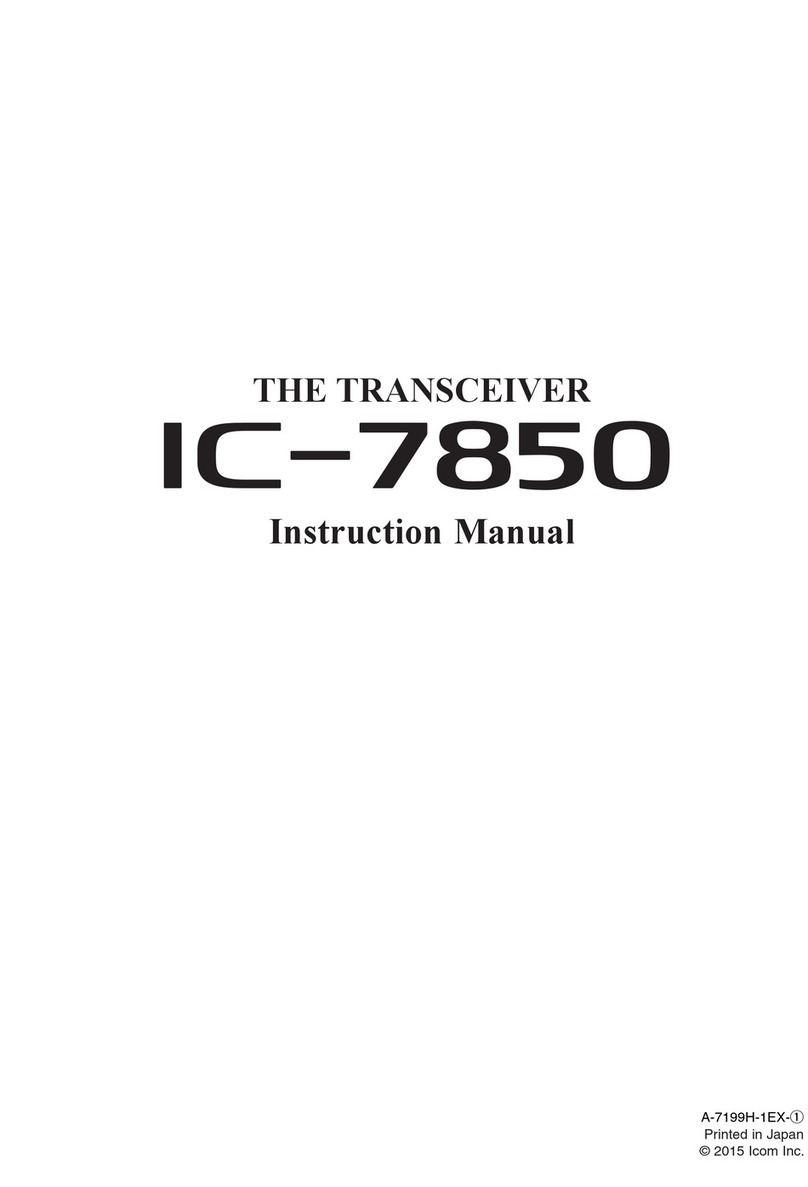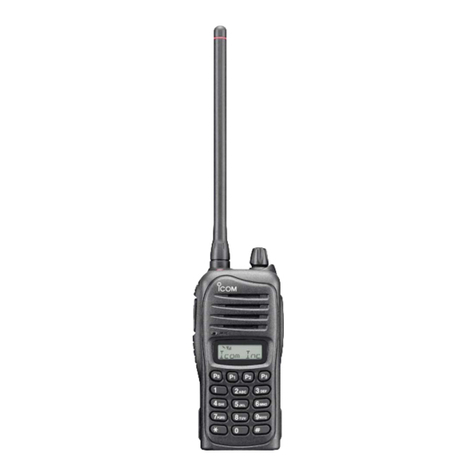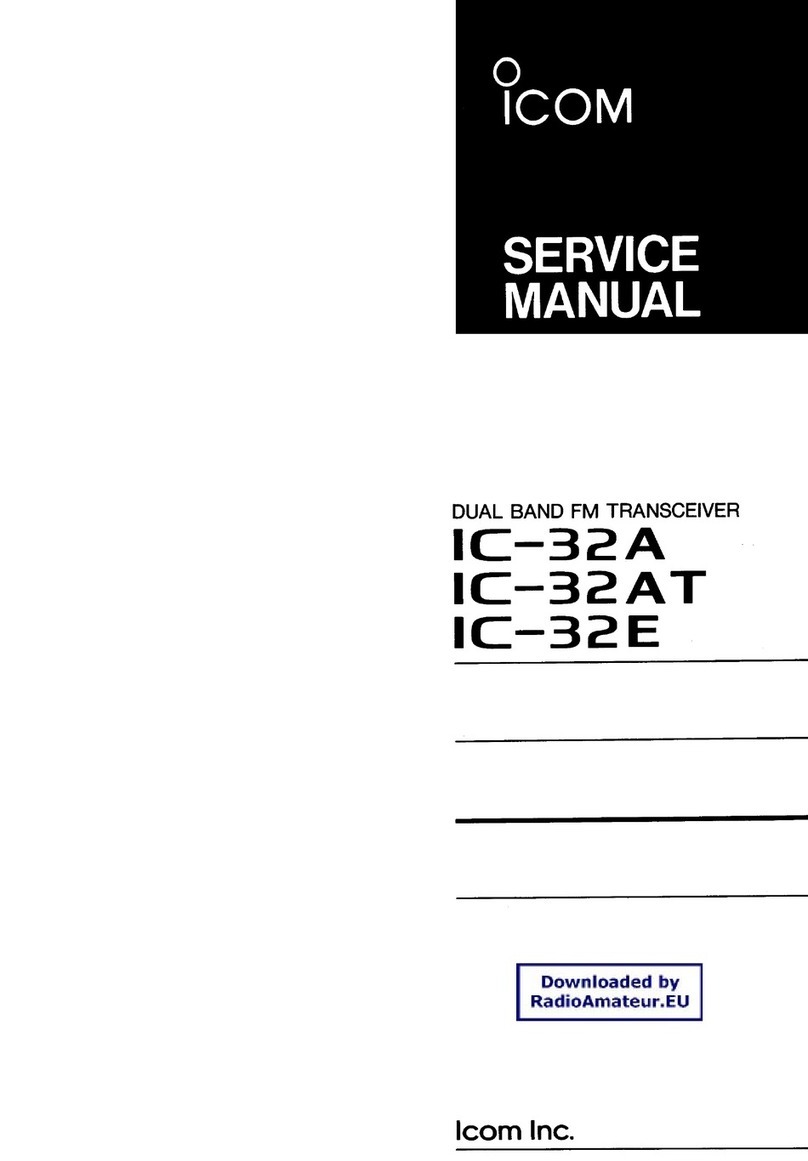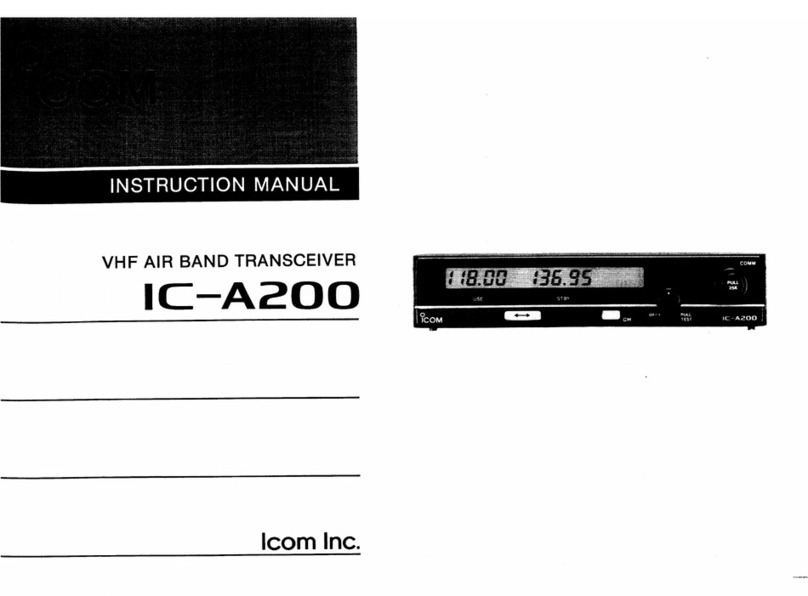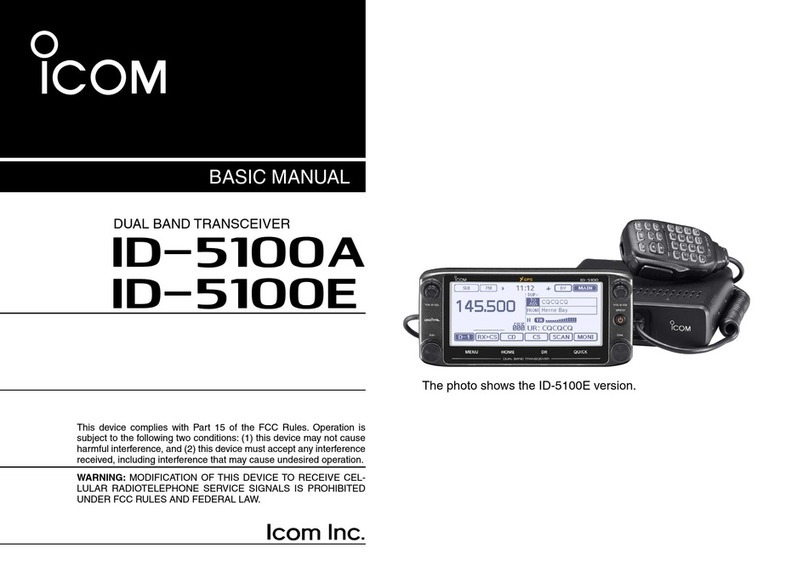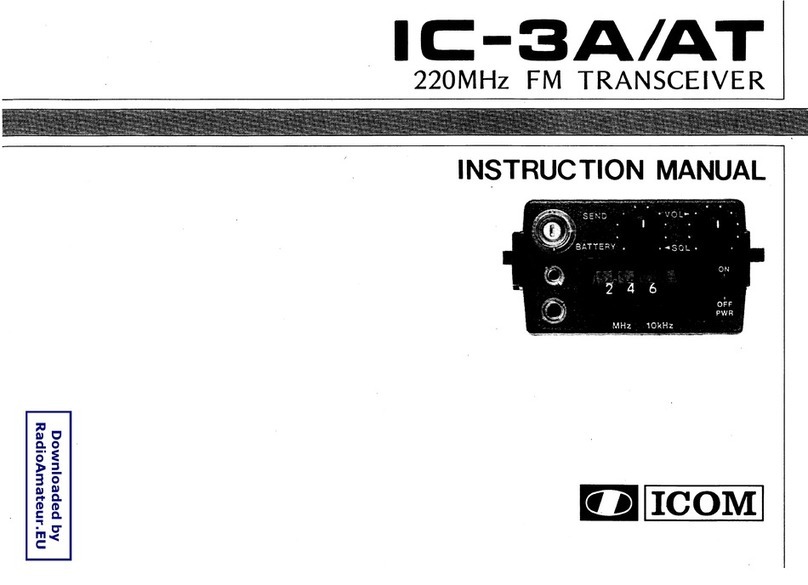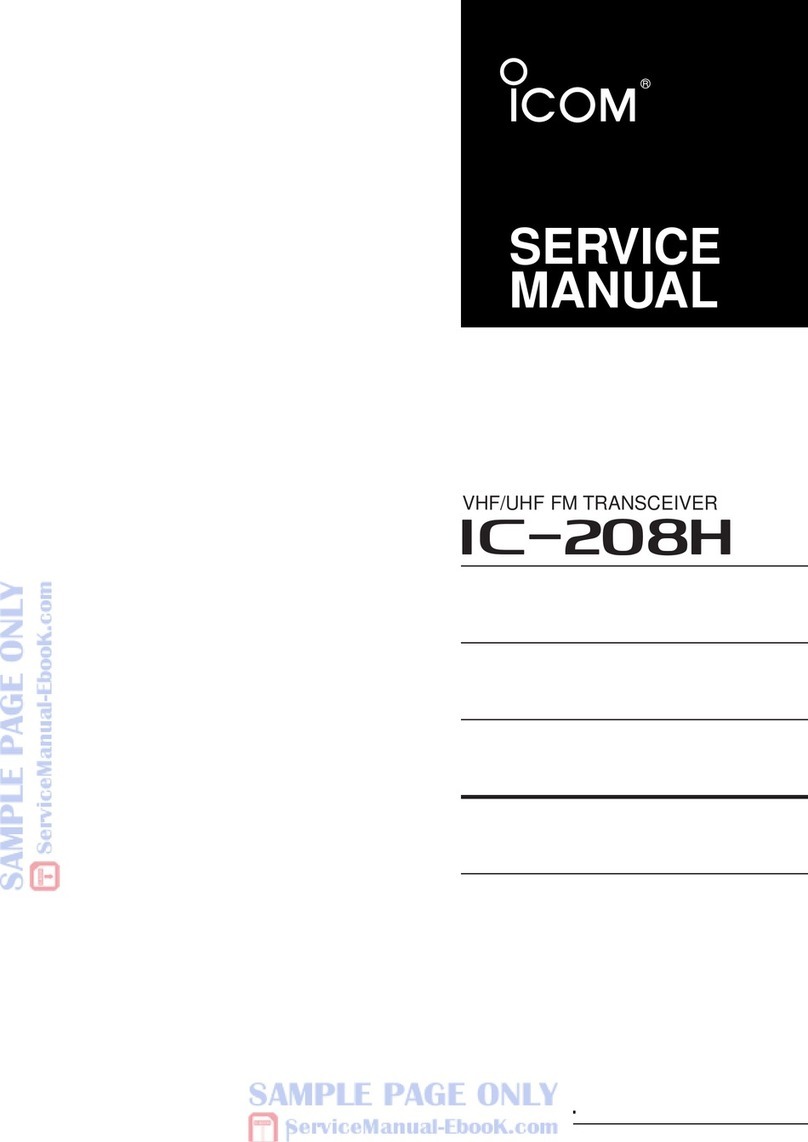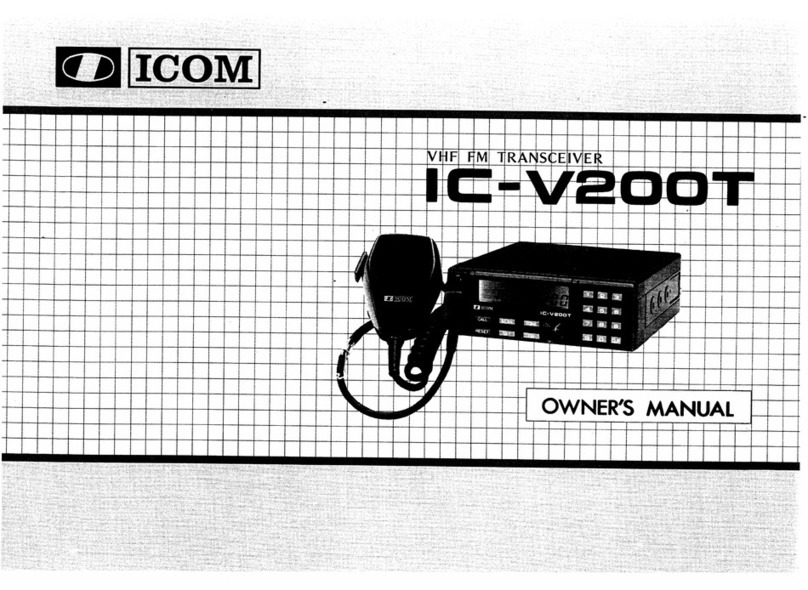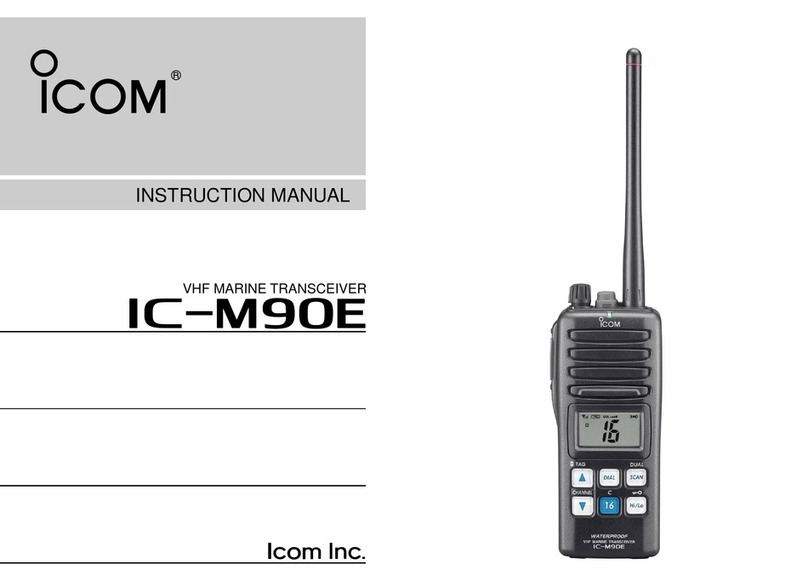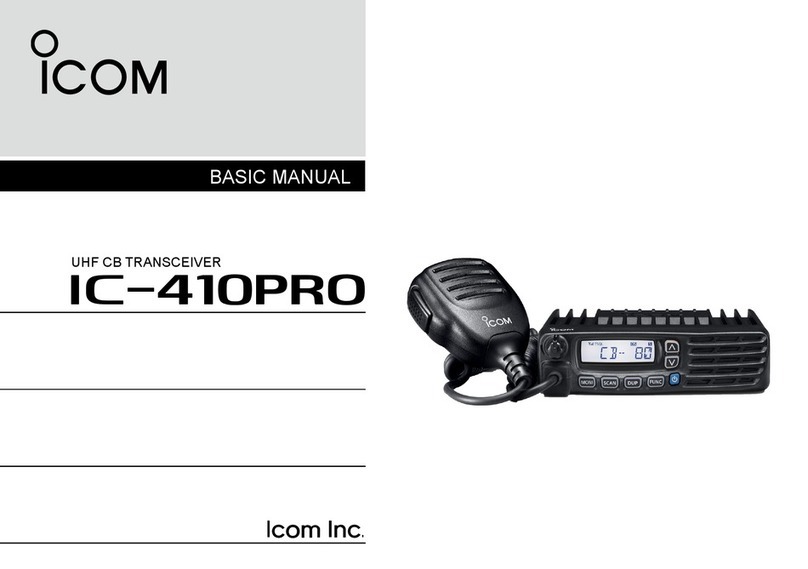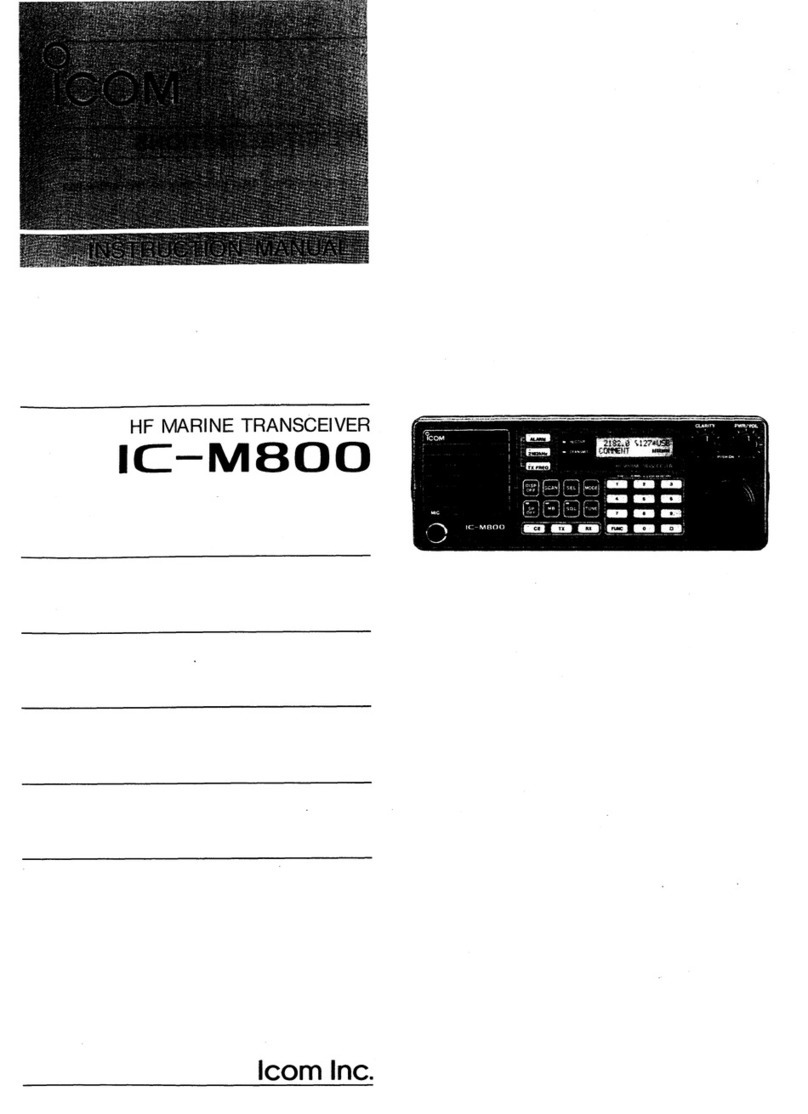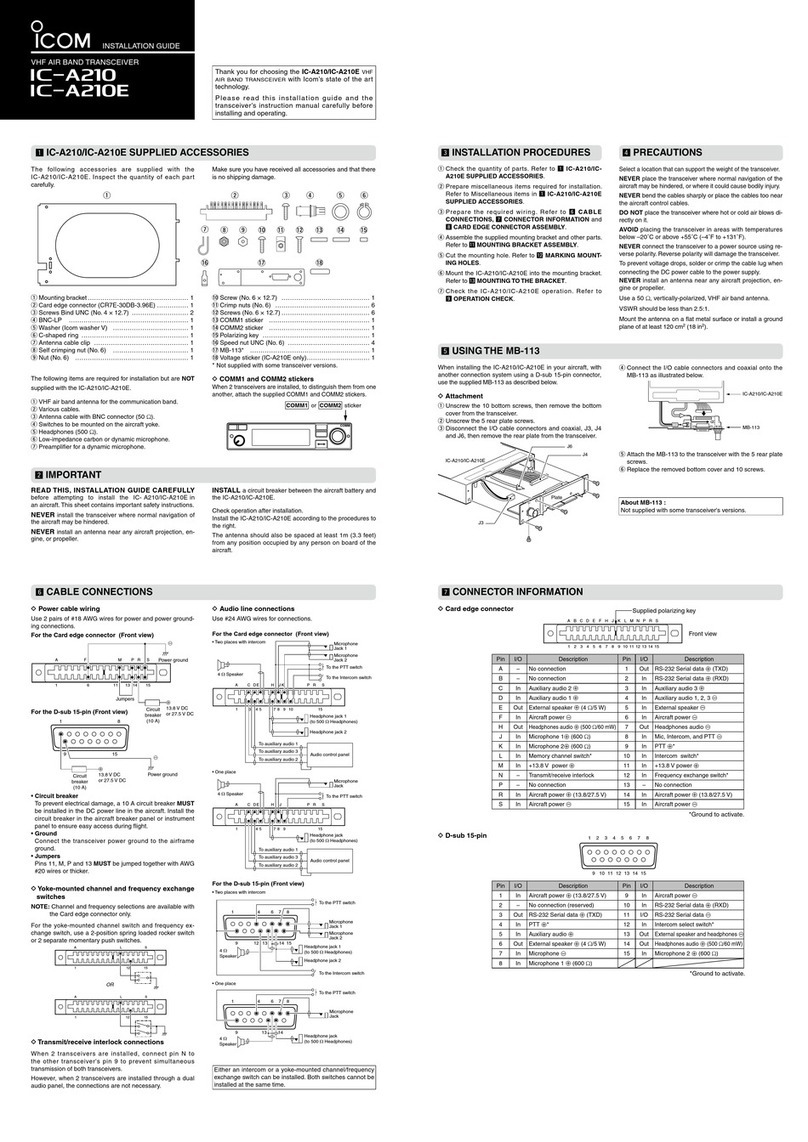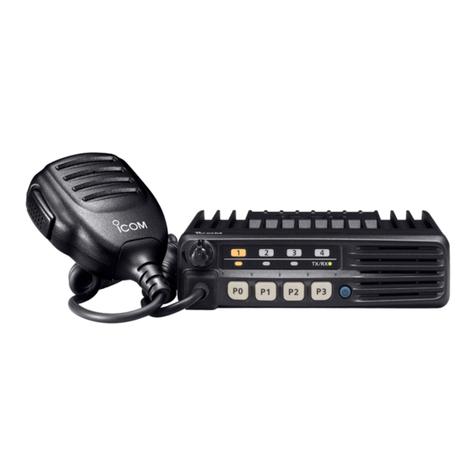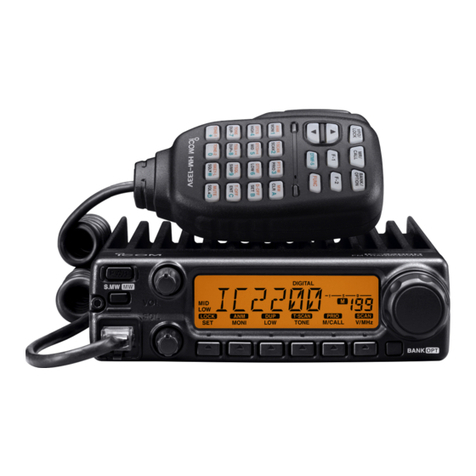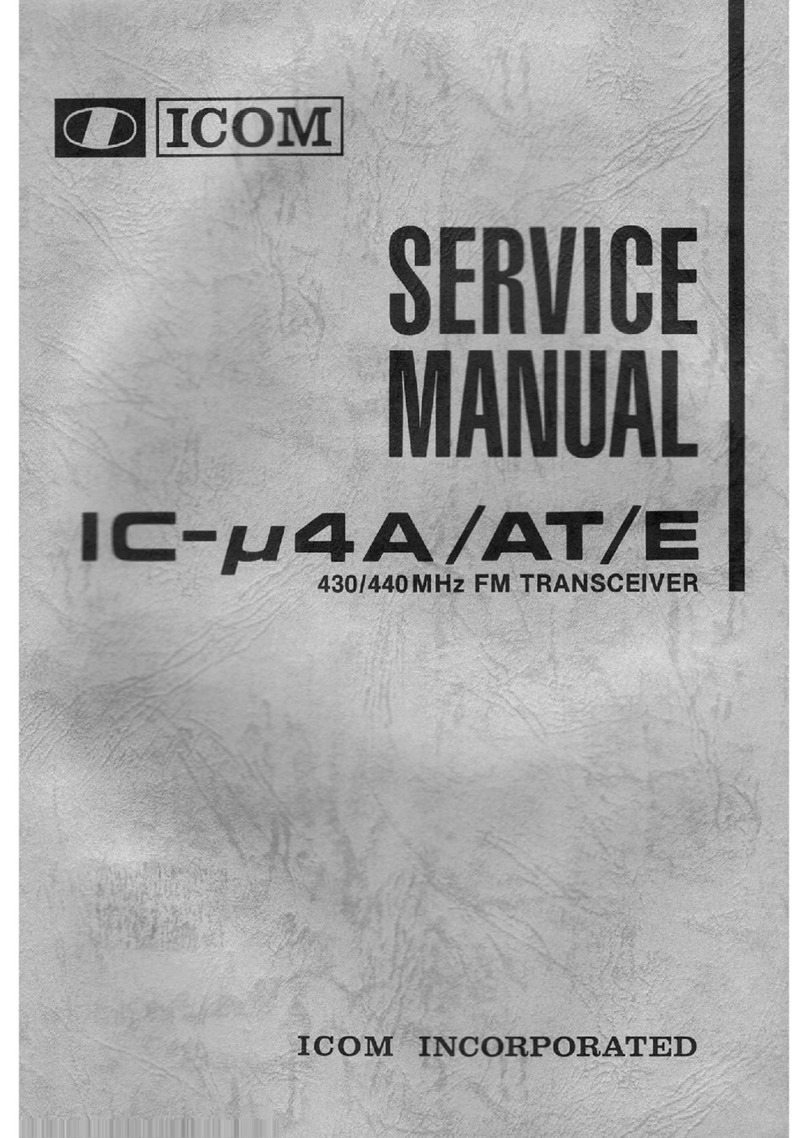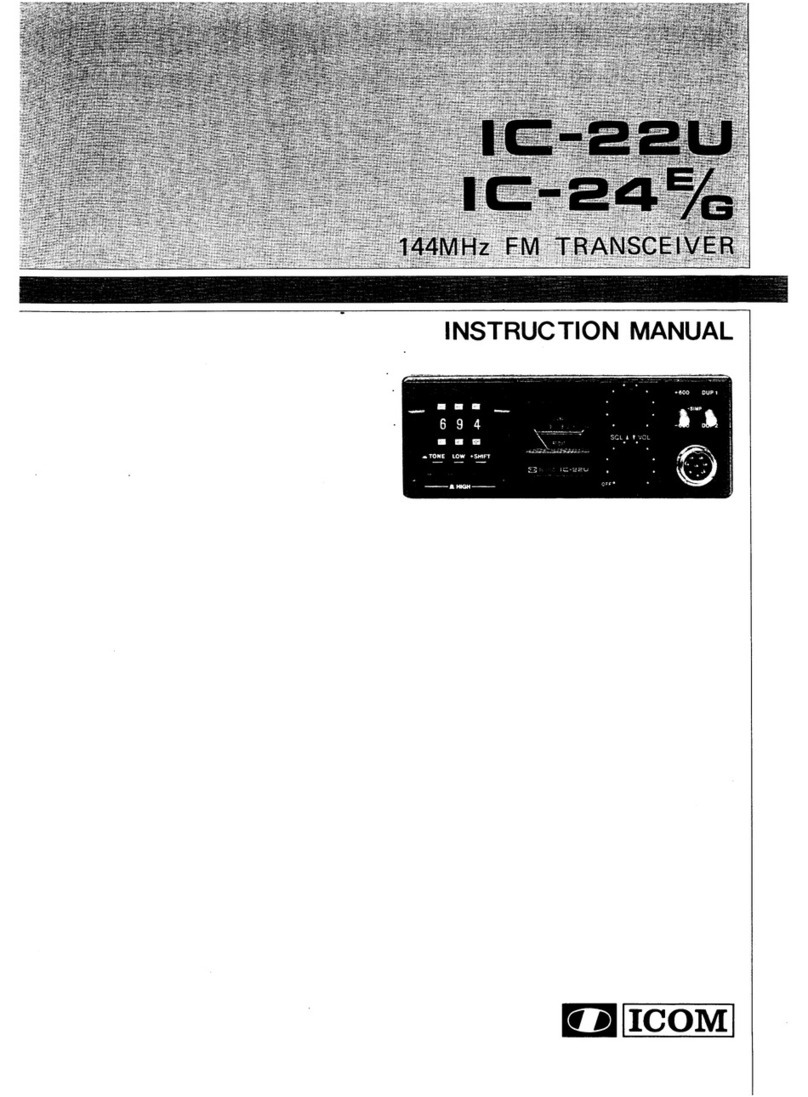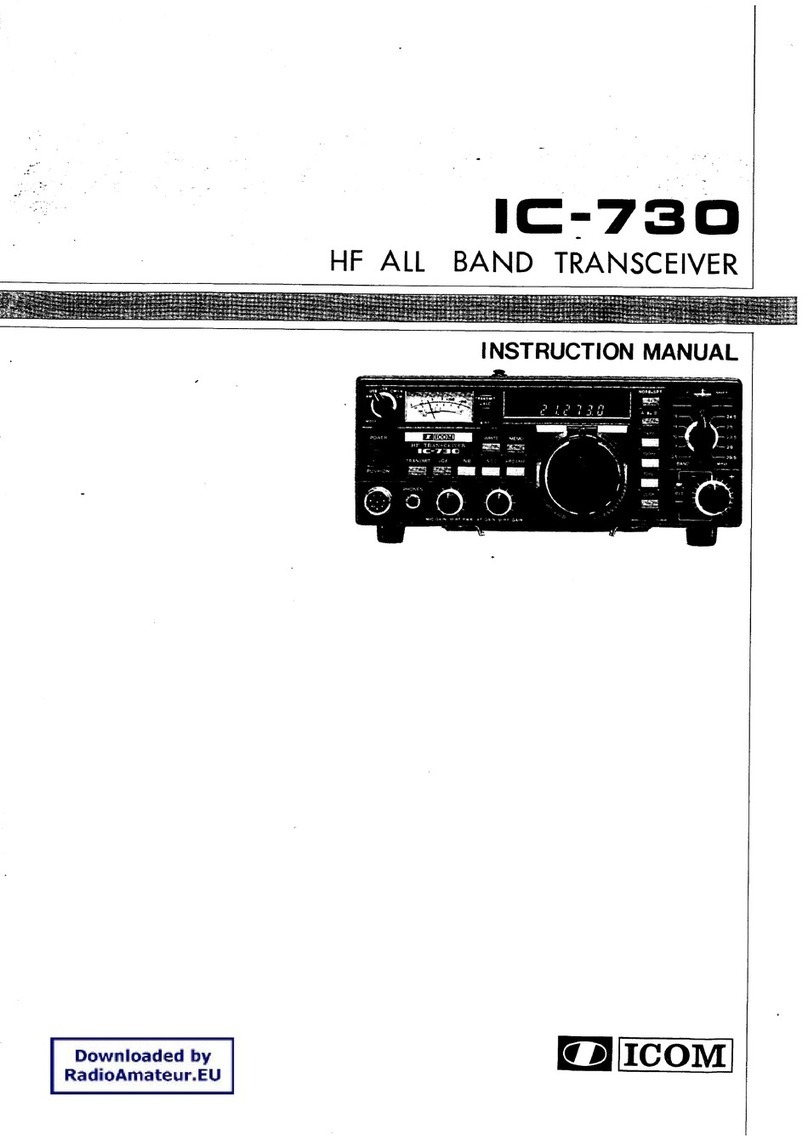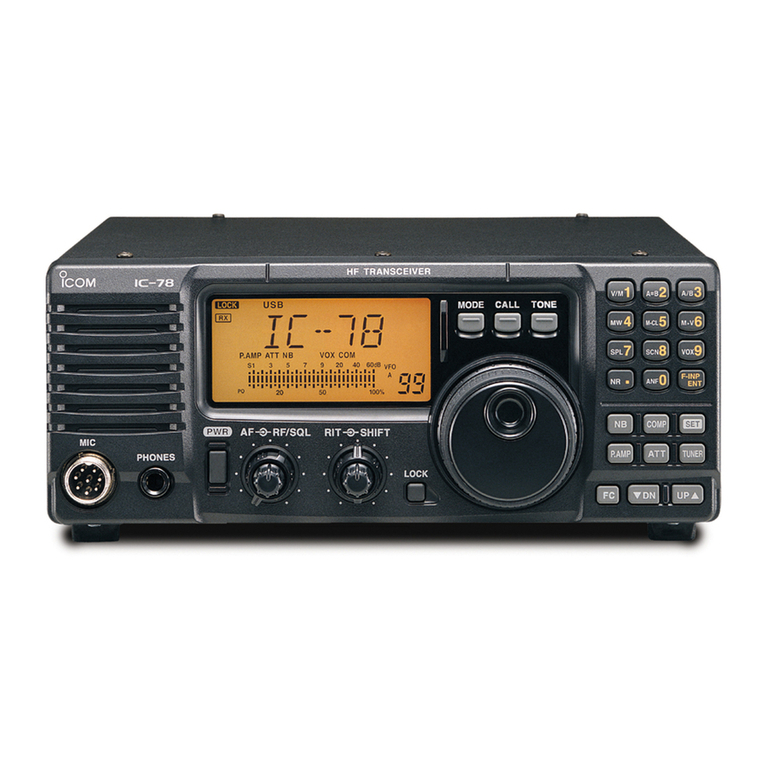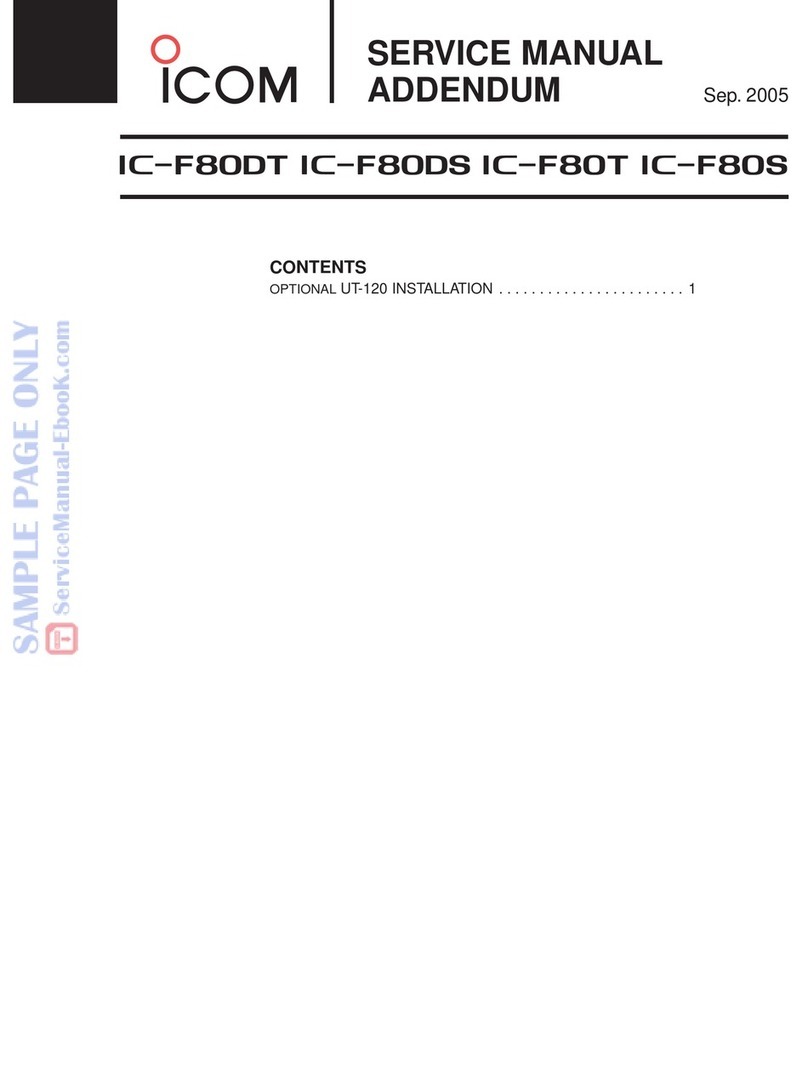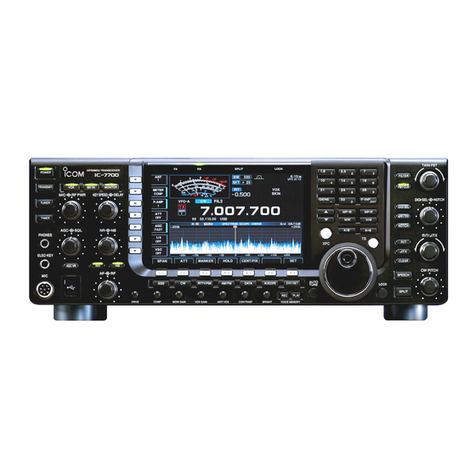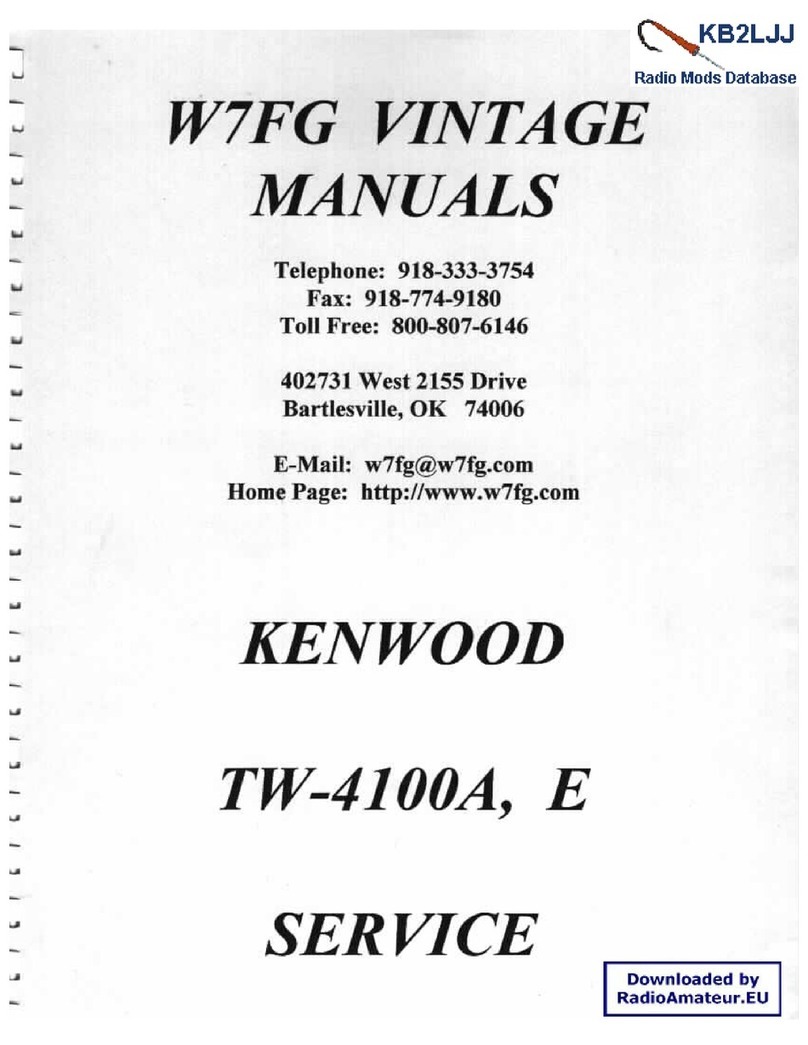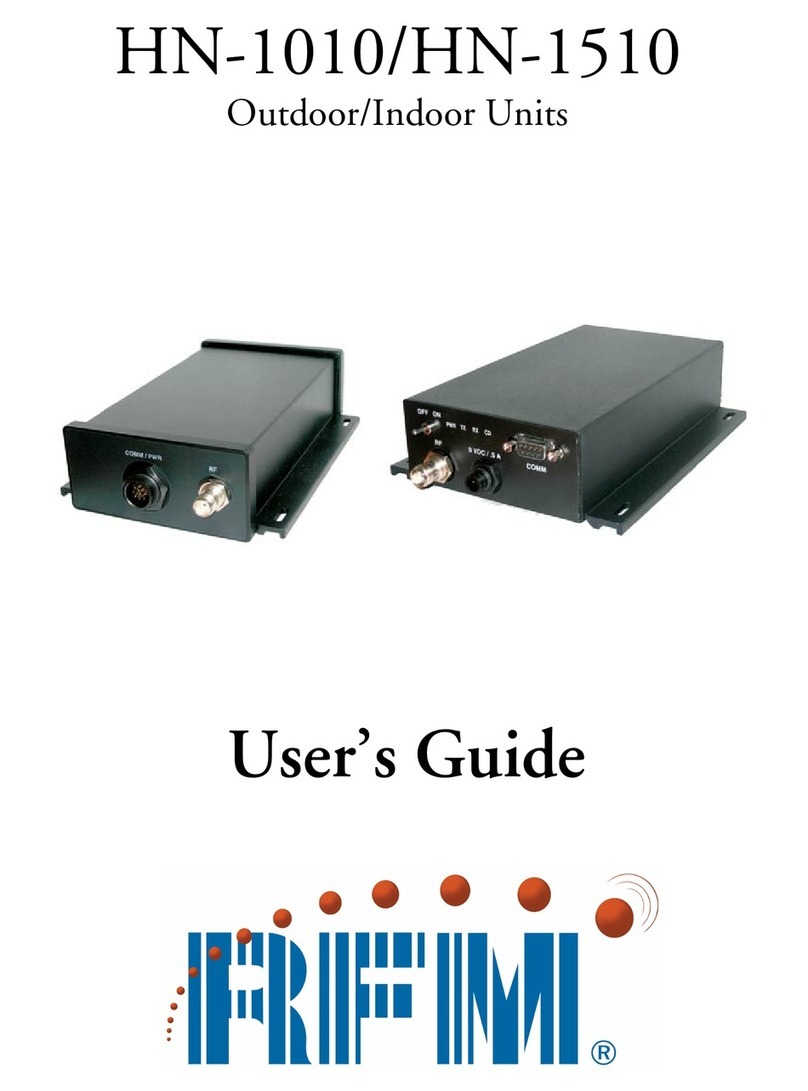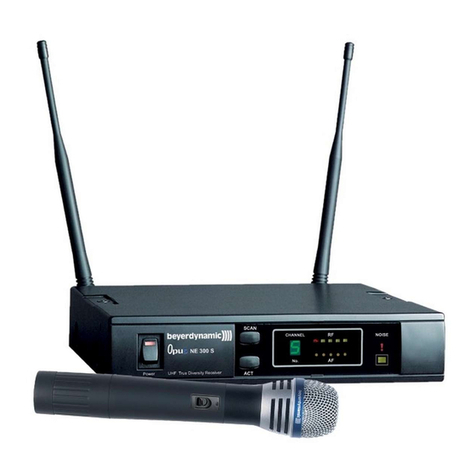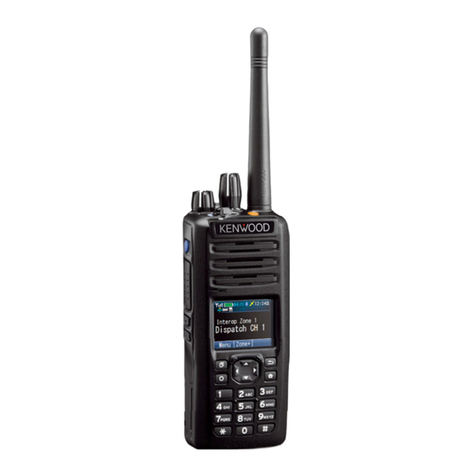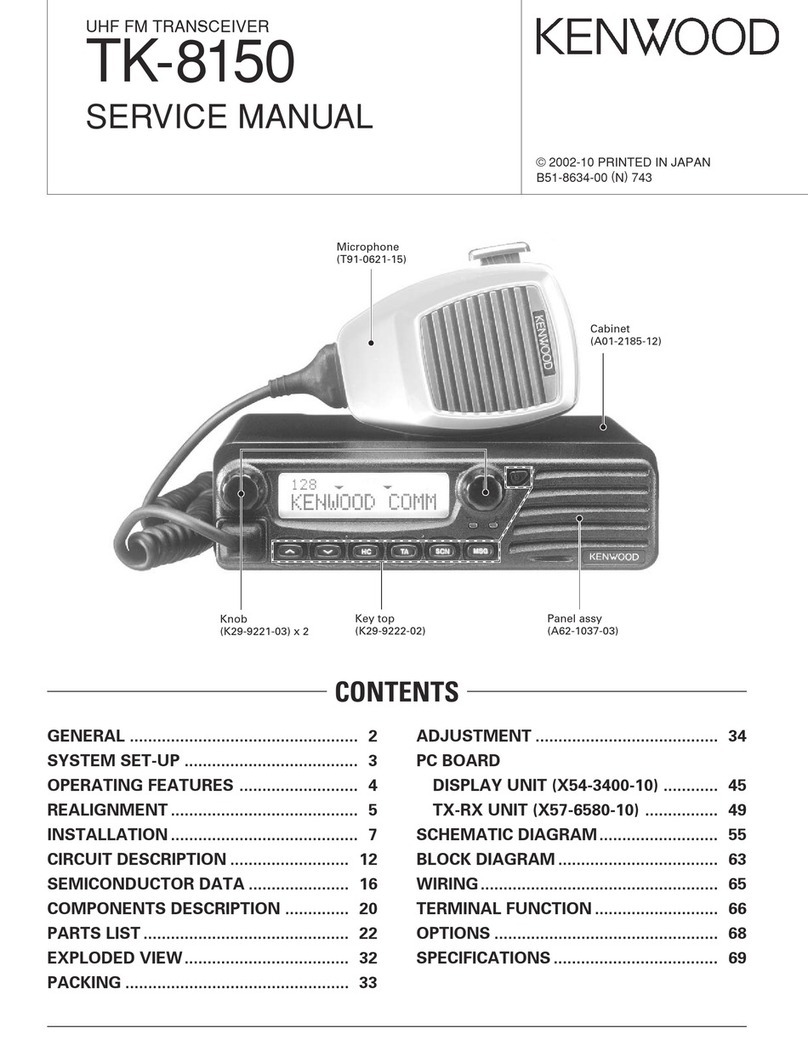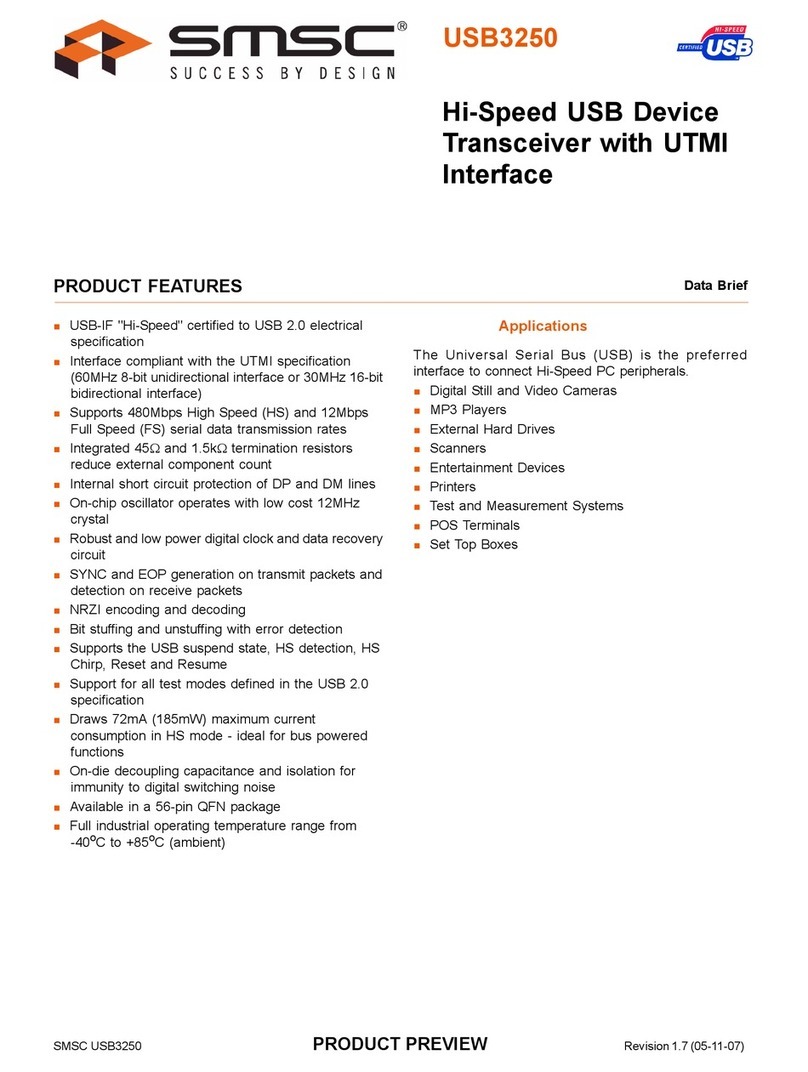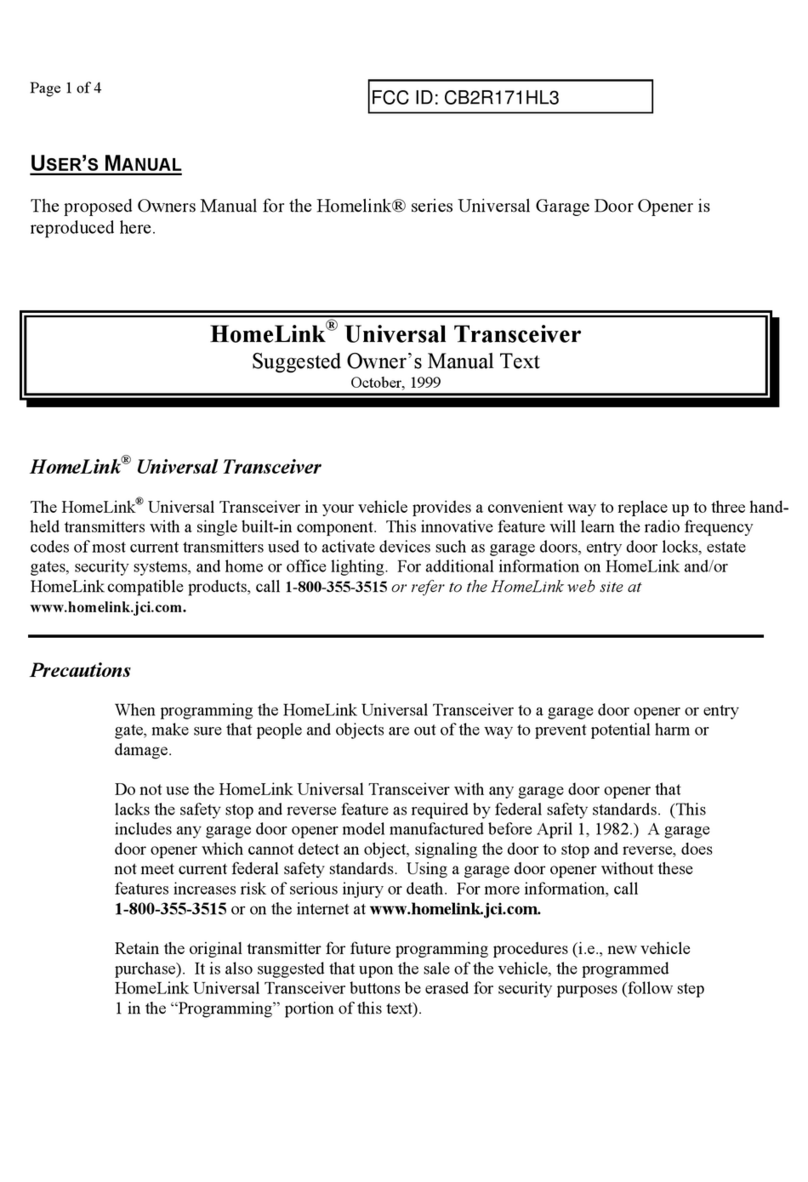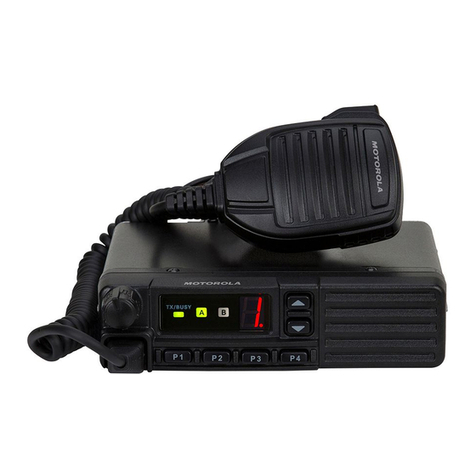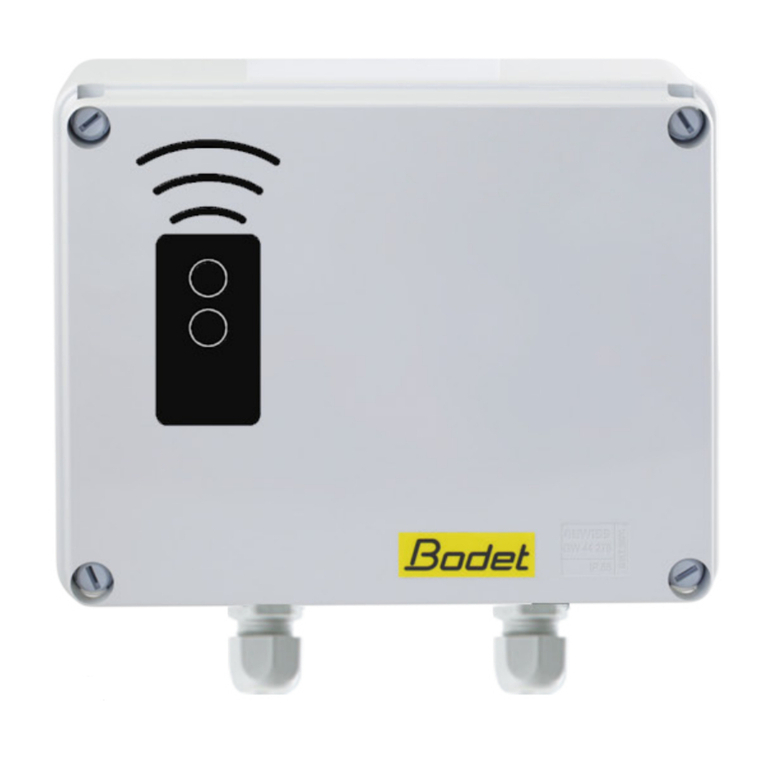Icom IC-E7 User manual

INSTRUCTION MANUAL
iE7
VHF/UHF DUAL BAND FM TRANSCEIVER
This device complies with Part 15 of the FCC rules. Operation is sub-
ject to the following two conditions: (1) This device may not cause
harmful interference, and (2) this device must accept any interference
received, including interference that may cause undesired operation.
WARNING: MODIFICATION OF THIS DEVICE TO RECEIVE CEL-
LULAR RADIO TELEPHONE SERVICE SIGNALS IS PROHIBITED
UNDER FCC RULES AND FEDERAL LAW.

i
FOREWORD
Thank you for purchasing this Icom product. The IC-E7
VHF
/
UHF
DUAL BAND FM TRANSCEIVER
is designed and built with Icom’s
superior technology and craftsmanship. With proper care, this
product should provide you with years of trouble-free operation.
We want to take a couple of moments of your time to thank you
for making your IC-E7 your radio of choice, and hope you agree
with Icom’s philosophy of “technology first.” Many hours of re-
search and development went into the design of your IC-E7.
DD
FEATURES
❍Covers the 0.495–999.990 MHz*
frequency range
*Some frequency bands are disabled according to version
❍CTCSS and DTCS encoder/decoder stan-
dard
❍1250 memory channels* with 18 banks
available
*200 auto write and 50 scan edge channels are included.
❍
1800 mAh large capacity Li-Ion battery
standard
IMPORTANT
READ ALL INSTRUCTIONS carefully and completely
before using the transceiver.
SAVE THIS INSTRUCTION MANUAL— This in-
struction manual contains important operating instructions for
the IC-E7.
EXPLICIT DEFINITIONS
WORD DEFINITION
RWARNING!
CAUTION
NOTE
Personal injury, fire hazard or electric shock
may occur.
Equipment damage may occur.
Recommended for optimum use. No risk of
personal injury, fire or electric shock.
Icom, Icom Inc. and the logo are registered trademarks of Icom
Incorporated (Japan) in the United States, the United Kingdom, Ger-
many, France, Spain, Russia and/or other countries.

RWARNING RF EXPOSURE! This device emits
Radio Frequency (RF) energy. Caution should be observed
when operating this device. If you have any questions re-
garding RF exposure and safety standards please refer to the
Federal Communications Commission Office of Engineering
and Technology’s report on Evaluating Compliance with FCC
Guidelines for Human Radio Frequency Electromagnetic
Fields (OET Bulletin 65)
RWARNING! NEVER hold the transceiver so that the
antenna is very close to, or touching exposed parts of the
body, especially the face or eyes, while transmitting. The
transceiver will perform best if the microphone is 5 to 10 cm
(2 to 4 inches) away from the lips and the transceiver is verti-
cal.
RWARNING! NEVER operate the transceiver with a
earphone, headphones or other audio accessories at high
volume levels. Hearing experts advise against continuous
high volume operation. If you experience a ringing in your
ears, reduce the volume level or discontinue use.
RWARNING! NEVER operate the transceiver while
driving a vehicle. Safe driving requires your full attention—
anything less may result in an accident.
NEVERexpose the transceiver to rain, snow or any liquids.
The transceiver may be damaged.
NEVER operate or touch the transceiver with wet hands.
This may result in an electric shock or damage the trans-
ceiver.
DO NOTpush the PTT when not actually desiring to trans-
mit.
AVOID using or placing the transceiver in direct sunlight or
in areas with temperatures below –10°C (+14˚F) or above
+60°C (+140˚F).
Place the unit in a secure place to avoid inadvertent use by
children.
AVOID the use of chemical agents such as benzine or al-
cohol when cleaning, as they can damage the transceiver’s
surfaces.
ii
PRECAUTION

iii
SUPPLIED ACCESSORIES
qBattery pack (BP-243) ………………………………………1
wBattery charger (BC-164) …………………………………1
eAntenna ………………………………………………………1
rHandstrap ……………………………………………………1
tAC adapter* (BC-145LE/LUK) ……………………………1
(The shape of the BC-145LE and BC-145LUK are different.)
*Depending on versions. Not supplied with some versions.
qw er
t
TABLE OF CONTENTS
FOREWORD ............................................................................................. i
IMPORTANT ............................................................................................. i
EXPLICIT DEFINITIONS .......................................................................... i
PRECAUTION .......................................................................................... ii
SUPPLIED ACCESSORIES .................................................................... iii
TABLE OF CONTENTS ........................................................................... iii
QUICK REFERENCE GUIDE ........................................................... I–VIII
■Preparation........................................................................................ I
■Your first contact.............................................................................. III
■Repeater operation .......................................................................... V
■Memory programming..................................................................... VI
■Programmed scan operation.......................................................... VII
1PANEL DESCRIPTION ................................................................... 1–4
■Front, top and side panels ............................................................... 1
■Function display .............................................................................. 3
2BATTERY CHARGING ................................................................... 5–8
■Caution............................................................................................. 5
■Battery installation ............................................................................ 7
■Battery charging ............................................................................... 8
3FREQUENCY AND CHANNEL SETTING .................................... 9–12
■VFO and memory channels.............................................................. 9
■Operating band selection ................................................................. 9
■Setting a frequency......................................................................... 11
■Setting a tuning step....................................................................... 11
■Selecting a memory channel.......................................................... 12
■Selecting a call channel.................................................................. 12
4BASIC OPERATION ................................................................... 13–18
■Receiving........................................................................................ 13
■Setting audio volume...................................................................... 13
■Squelch level setting ...................................................................... 14
■Operating mode selection .............................................................. 14
■Monitor function.............................................................................. 15
■Attenuator function ......................................................................... 15

iv
1
2
3
4
5
6
7
8
9
10
11
12
13
14
15
■Transmitting.................................................................................... 16
■Transmit power selection ............................................................... 16
■Dial select step............................................................................... 17
■Lock function .................................................................................. 18
■[DIAL] function assignment ............................................................ 18
5REPEATER OPERATION............................................................ 19–23
■General........................................................................................... 19
■Offset frequency ............................................................................. 20
■Subaudible tones............................................................................ 21
■1750 Hz tone.................................................................................. 23
6MEMORY/CALL CHANNELS ..................................................... 24–33
■General description ........................................................................ 24
■Memory channel programming....................................................... 24
■Memory bank setting...................................................................... 25
■Memory bank selection .................................................................. 26
■Programming memory/bank name ................................................. 27
■Selecting display type..................................................................... 28
■Copying memory contents.............................................................. 29
■Memory clearing............................................................................. 30
■Transferring memory contents ....................................................... 31
■Erasing/transferring bank contents................................................. 32
■Call channel programming ............................................................. 33
■Copying call channel contents........................................................ 33
7SCAN OPERATION .................................................................... 34–41
■Scan types...................................................................................... 34
■Full/band/programmed scan........................................................... 35
■Scan edges programming .............................................................. 36
■Memory/bank scan ......................................................................... 37
■Auto memory write scan................................................................. 38
■Skip channel/frequency setting ...................................................... 39
■Scan resume condition................................................................... 41
8PRIORITY WATCH ..................................................................... 42–44
■Priority watch types ........................................................................ 42
■Priority watch operation.................................................................. 43
9TONE SQUELCH AND POCKET BEEP .................................... 45–48
■Tone/DTCS squelch operation ....................................................... 45
■Tone squelch frequency/DTCS code setting .................................. 46
■DTCS polarity setting ..................................................................... 47
■Tone scan ....................................................................................... 48
10 SET MODE ................................................................................. 49–59
■General........................................................................................... 49
■Set mode items .............................................................................. 50
11 OTHER FUNCTIONS ................................................................. 60–64
■Data cloning .................................................................................. 60
■Auto power-off function .................................................................. 61
■TV channel operation ..................................................................... 62
■All reset ......................................................................................... 63
■Partial reset .................................................................................... 64
12 FREQUENCY TABLE ................................................................. 65–72
■TV channels ................................................................................... 65
■VHF marine channels..................................................................... 68
■Weather channels .......................................................................... 68
■Other communications in the USA ................................................. 69
■Other communications—other countries ........................................ 71
13 MAINTENANCE ......................................................................... 73–74
■Troubleshooting.............................................................................. 73
■Optional CP-21LR fuse replacement.............................................. 74
14 SPECIFICATIONS ...................................................................... 75–76
■Transceiver..................................................................................... 75
■Battery pack (BP-243).................................................................... 76
■Battery charger (BC-164) ............................................................... 76
15 OPTIONS .................................................................................... 77–79
■Options........................................................................................... 77
16 POCKET GUIDE ......................................................................... 80–81
17 CE ..................................................................................................... 82
16
17

I
QUICK REFERENCE GUIDE
■Preparation
DBattery installation
qRemove the battery cover from the transceiver.
wInstall the BP-243 (Li-Ion battery pack).
•Be sure to observe the correct polarity.
eReplace the battery cover to the transceiver.
Keep the battery contacts clean. It’s a good idea to clean
the battery terminals once a week.
DDAntenna
Insert the supplied antenna into the
antenna connector and screw down
the antenna as shown at right.
NEVER hold the antenna when car-
rying the transceiver.
Keep the jack cover attached when
jack is not in use to protect the con-
nector from dust and moisture.
✔
For your information
Third-party antennas may increase transceiver perfor-
mance. An optional AD-92SMA
ANTENNA CONNECTOR
ADAPTER
is available to connect an antenna with a BNC
connector.
DHandstrap
Slide the handstrap through the
loop on the top of the rear panel as
illustrated at right. Facilities carry-
ing.
OrderOrder
Facing up this side
e
r
t
w
q

II
QUICK REFERENCE GUIDE
DCharging the battery
RRWARNING!:
NEVER charge any other than the specified battery pack.
DCharging description
qPlug the AC adapter into an AC outlet; or the optional CP-
21LR into a cigarette lighter socket.
wInsert the adapter plug into [12~16V DC INPUT] of the BC-
164
BATTERY CHARGER
.
eInstall the BP-243
BATTERY PACK
(see left page) to the
transceiver.
rBe sure to turn OFF the transceiver, then charge the bat-
tery with transceiver.
•Takes approximately 3 hours for fully charge with the supplied
BP-243 battery pack.
•Charging indicator of BC-164 lights or blinks as follows.
*It may be charging outside of the specified temperature range: +5˚C to
+35˚C (+41˚F to +95˚F). Restore the specified temperature range and
reinsert the transceiver.
NOTE: The transceiver has battery indicator to show the
following information.
•No indicator appears when the installed battery pack has
ample capacity.
•“”(battery indicator) appears when the battery pack
is nearing exhaustion.
•“”blinks when the battery pack must be charged.
•“”and “LOW” indicator appear just before the battery
pack is completely discharged and display turns OFF.
BC-164
Charging
indicator
Transceiver to [12~16V DC INPUT] jack
AC adapter
to cigarette
lighter socket
to AC outlet
SCAN
SET
S.MW
Optional CP-21LR
Cigarette lighter cable
with noise filter
Quick reference guide
Charging indicator status Charging status
Lights orange Charging
Lights green Charging is completed
Blinking red Charging error*

III
QUICK REFERENCE GUIDE
■Your first contact
Now that you have your IC-E7 ready, you are probably ex-
cited to get on the air. We would like to take you through a
few basic steps to make your first experience “On The Air” en-
joyable.
DAbout default settings
The [DIAL] control function can be exchanged with the
[YY]/[ZZ]key functions by pushing and holding [FUNC] then
push [YY]or [ZZ]. However, in this QUICK REFERENCE
GUIDE, the factory default setting ([DIAL] sets operating fre-
quency) is used to simplify the instructions.
DBasic operation
1. Turning ON the transceiver
➥Push and hold [PWR] for 1
sec. to turn the power ON.
•Opening indication passes
through, then frequency indica-
tion appears.
The opening indication can
be skipped. While pushing
and holding [FUNC], push
and hold [PWR] for 1 sec. to
shortcut the opening indica-
tion.
2. Adjusting audio level
➥Push [YY]/[ZZ]to set the desired audio level.
3. Adjusting squelch level
➥While pushing and holding [SQL] (
ATT
•
SET
), rotate [DIAL]
to set the squelch level.
SCAN
SET
S.MW
[DIAL]
[SQL]
SCAN
SET
S.MW
[Y]/[Z]
SCAN
SET
S.MW
[PWR]

IV
QUICK REFERENCE GUIDE
4. Tune the desired frequency
The tuning dial will allow you to dial in the frequency you want
to use. Pages 11 and 17 will instruct you on how to set the
tuning step size.
qPush [BAND] (
TS
•
LOCK
)sev-
eral times to select the de-
sired frequency band.
•While pushing and holding
[BAND] (
TS
•
LOCK
), rotating
[DIAL] also selects frequency
band.
wRotate [DIAL] to set the de-
sired frequency.
•While pushing and holding
[FUNC], rotate [DIAL] to select
frequency in 1 MHz steps.
5. Operating mode selection
➥While pushing and holding
[FUNC], push [CALL]
(
MODE
•
SCAN
)several times to
select the desired operating
mode.
•FM, WFM and AM modes are
selectable.
•WFM mode is not selectable
below 30 MHz band.
6. Transmit and receive
➥Push and hold [PTT] to trans-
mit then speak into the micro-
phone; release to receive.
•Transmission is available on the
144 MHz/430 MHz (FM mode)
amateur bands only.
SCAN
SET
S.MW
Microphone
[PTT]
SCAN
SET
S.MW
[CALL]
[FUNC]
SCAN
SET
S.MW
[FUNC]
[BAND]
[DIAL]
Quick reference guide

V
QUICK REFERENCE GUIDE
■Repeater operation
1. Setting duplex
qWhile pushing and holding
[FUNC], push and hold [SQL]
(
ATT
•
SET
)for 1 sec. to enter set
mode.
wRotate [DIAL] to select “DUP.”
eWhile pushing and holding
[FUNC], rotate [DIAL] to select
minus duplex or plus duplex.
rPush [SQL] (
ATT
•
SET
) to exit set mode.
2. Repeater tone
qWhile pushing and holding
[FUNC], push and hold [SQL]
(
ATT
•
SET
)for 1 sec. to enter set
mode.
wRotate [DIAL] to select
“T/TSQL.”
eWhile pushing and holding
[FUNC], rotate [DIAL] to select
the repeater tone activation.
rPush [SQL] (
ATT
•
SET
) to exit set mode.
NOTE: The transceiver can transmit a 1750 Hz tone burst.
Push [PTT] briefly, then push and hold [PTT] for 1 to 2
sec. to transmit a 1750 Hz tone burst. (p.23)
ATT
DTCS
TSQL
WFMAM -DUP
LOW
VOL PRIOP SKIP
MR
5
19
ATT
DTCS
TSQL
WFMAM -DUP
LOW
VOL PRIOP SKIP
MR
5
19
ATT
DTCS
TSQL
WFMAM -DUP
LOW
VOL PRIOP SKIP
MR
5
19
SCAN
SET
S.MW
[SQL]
[FUNC]
[DIAL]
ATT
DTCS
TSQL
WFMAM -DUP
LOW
VOL PRIOP SKIP
MR
5
19
ATT
DTCS
TSQL
WFMAM -DUP
LOW
VOL PRIOP SKIP
MR
5
19
ATT
DTCS
TSQL
WFMAM -DUP
LOW
VOL PRIOP SKIP
MR
5
19
SCAN
SET
S.MW
[SQL]
[FUNC]
[DIAL]

VI
QUICK REFERENCE GUIDE
Quick reference guide
■Memory programming
The IC-E7 has a total of 1250 memory channels (including
200 auto write channels and 50 scan edges) for storing often
used operating frequency, mode, etc.
1. Setting frequency
In VFO mode, set the desired receive frequency mode.
•When “ ” indicator is displayed, push [V/M] (
SKIP
•
S
.
MW
)to select
the VFO mode.
2. Selecting a memory channel
Push [V/M] (
SKIP
•
S
.
MW
)for 1 sec. to
enter select memory write mode
(
1short and 1 long beep sound)
,
then rotate [DIAL] to select the de-
sired memory channel.
•“ ” indicator and memory channel
number blink.
•To cancel and exit select memory write mode, push
[V/M]
(
SKIP
•
S
.
MW
)
momentarily.
3. Writing a memory channel
Push and hold [V/M] (
SKIP
•
S
.
MW
)for 1 sec. until 3 beeps
sound.
•Memory channel number automatically increases when continuing
to push [V/M] (
SKIP
•
S
.
MW
)after programming.
SCAN
SET
S.MW
[V/M]
ATT
DTCS
TSQL
WFMAM -DUP
LOW
VOL PRIOP SKIP
MR
5
19
SCAN
SET
S.MW
[DIAL]
[V/M]

VII
QUICK REFERENCE GUIDE
■Programmed scan operation
50 channels of memories in 25 pairs are used to specify
scanning ranges for programmed scan operation. The pro-
grammed scan scans between “xxA” and “xxb” (xx=00 to 24)
channels. Therefore, before operating the programmed scan,
different frequencies must be programmed into the “A” and
“b” channels.
DDProgramming scan edges
Astart and stop frequency must be programmed into a pair
of "xxA" or "xxb" channels.
1. Setting frequency
In VFO mode, set the desired operating frequency and mode.
•When “ ” indicator is displayed, push [V/M] (
SKIP
•
S
.
MW
)to select
the VFO mode.
2. Selecting a scan edge channel “A”
Push and hold [V/M] (
SKIP
•
S
.
MW
)for 1
sec. to enter select memory write
mode (
1short and 1 long beep
sound)
,
then rotate [DIAL] to select
the desired scan edge channel “A.”
•“ ” indicator and scan edge channel
number blink.
3. Writing a memory channel
Push and hold [V/M] (
SKIP
•
S
.
MW
)for 1 sec. until 3 beeps
sound.
•Scan edge channel “b” is automatically selected when continuing to
push [V/M] (
SKIP
•
S
.
MW
)after programming.
•After programming is completed, the display returns to VFO indica-
tion.
4. Selecting a scan edge channel “b”
Push and hold [V/M] (
SKIP
•
S
.
MW
)for 1
sec.,
then rotate [DIAL] to select the
desired scan edge channel “b.”
•“ ” indicator and scan edge channel
number blink.
•When the scan edge channel “b” is already selected at step 3, con-
tinuing to push [V/M] (
SKIP
•
S
.
MW
)after programming, skip this step.
5. Writing a memory channel
Push and hold [V/M] (
SKIP
•
S
.
MW
)for 1 sec. until 3 beeps
sound.
•The next scan edge channel “A” is automatically selected when con-
tinuing to push [V/M] (
SKIP
•
S
.
MW
)after programming.
•After programming is completed, the display returns to VFO indica-
tion.
ATT
DTCS
TSQL
WFMAM -DUP
LOW
VOL PRIOPSKIP
MR
5
19
ATT
DTCS
TSQL
WFMAM -DUP
LOW
VOL PRIOP SKIP
MR
5
19

VIII
QUICK REFERENCE GUIDE
DDStarting scan
1. Select VFO mode.
Push [V/M] (
SKIP
•
S
.
MW
)to select the VFO mode for full, band
and programmed scan operation.
•Select memory mode by pushing [V/M] (
SKIP
•
S
.
MW
)again for mem-
ory or bank scan.
2. Selecting a scanning type
Push and hold [CALL] (
MODE
•
SCAN
)for 1 sec.,
then rotate
[DIAL] to select the desired scanning type.
•Available scan types when VFO mode is selected; “ALL” for full
scan; “BAND” for the selected band; one of “PROGxx” (xx=0 to 24)
for programmed scan.
•Available scan types when memory mode is selected; “M ALL” for all
memory scan “B ALL” for all bank scan, “B LINK” for bank link scan,
“BANK” for the selected bank scan.
3. Starting scan
Push [CALL] (
MODE
•
SCAN
)to start the scan.
•Rotate [DIAL] to change the scanning direction.
4. Cancelling scan
Push [CALL] (
MODE
•
SCAN
)again to stop scan.
✔
For your information
The memory channel number you program the scan edges
into correlate “PROGxx” as follows:
00A/00b: Select “PROG 00” to scan between frequencies
programmed in 00A and 00b channels.
•
•
•
•
24A/24b: Select “PROG 24” to scan between frequencies
programmed in 24A and 24b channels.
ATT
DTCS
TSQL
WFMAM -DUP
LOW
VOL PRIOP SKIP
MR
5
19
ATT
DTCS
TSQL
WFMAM -DUP
LOW
VOL PRIOP SKIP
MR
5
19
ATT
DTCS
TSQL
WFMAM -DUP
LOW
VOL PRIOP SKIP
MR
5
19
ATT
DTCS
TSQL
WFMAM -DUP
LOW
VOL PRIOP SKIP
MR
5
19
• Programmed scan• Full/Band scan
• Bank scan
• All memory/All bank/
Bank link scan
SCAN
SET
S.MW
[DIAL]
[CALL]
• Full scan
• Scan type indication examples
• Programmed scan
• Band scan
Quick reference guide

■Front, top and side panels
qANTENNA CONNECTOR (p. I)
Connects to the supplied antenna.
•An optional AD-92SMA adapter (p. 77) is available for connect-
ing an antenna with a BNC connector.
wEXTERNAL SPEAKER/MICROPHONE JACK [MIC/SP]
Connects an optional speaker-microphone or headset via
an optional †OPC-782
PLUG ADAPTOR CABLE
, if desired.
The internal microphone and speaker will not function
when the †OPC-782 is connected. (See p. 77 for a list of
available options.)
†An optional HM-153P
TIE
-
PIN MICROPHONE
can be connected to
the IC-E7 directly (without the OPC-782).
ePTT SWITCH [PTT] (p. 16)
➥Push and hold to transmit, release to receive.
➥Push briefly, then push and hold to transmit a 1750 Hz
tone burst. (p. 23)
➥While pushing and holding [FUNC], push to toggle the
transmit output power between High and Low.
rFUNCTION KEY [FUNC]
Push and hold this key for access to secondary functions.
tUP/DOWN KEYS [YY]/[ZZ]
➥Adjusts audio volume level.* (p. 13)
➥While pushing and holding [FUNC], push either key to
exchange [DIAL] and [YY]/[ZZ]function. (p. 18)
SCAN
S.MW
SET
Function display
(pgs 3, 4)
Speaker
Microphone
!1
!0
!2
t
r
y
u
i
e
w
q
o
1
PANEL DESCRIPTION
1
*The function of [DIAL] and [YY]/[ZZ]can be exchanged. See page
18 for details.

2
1
PANEL DESCRIPTION
1
yCALL•MODE•SCAN KEY [CALL] (
MODE
•
SCAN
)
➥Push momentarily to select the call channel. (p. 12)
➥Push and hold for 1 sec. to enter the scan type selection
condition, push again to start a scan. (p. 35)
➥While pushing and holding [FUNC], push momentarily
to select the operating mode. (p. 14)
➥While pushing and holding [FUNC], push and hold for
1 sec. to start a tone scan. (p. 48)
uVFO/MEMORY•MEMORY WRITE KEY [V/M] (
SKIP
•
S
.
MW
)
➥Push momentarily to toggle between VFO and memory
mode. (p. 9)
➥Push and hold for 1 sec. to enter select memory write
mode. (p. 24)
➥While pushing and holding [FUNC], push momentarily
to select scan skip condition. (p. 40)
➥During VFO scan, pushing and holding [FUNC], push
and hold for 1 sec. to store into highest blank memory
channel as PSKIP channel (p. 40)
iSQUELCH•ATTENUATOR•SET KEY [SQL] (
ATT
•
SET
)
➥Push and hold to open the squelch temporarily and
monitor the operating frequency. (p. 15)
➥While pushing and holding this key, rotate [DIAL]* to ad-
just the squelch level. (p. 14)
➥While pushing and holding [FUNC], push and hold for
1 sec. to enter set mode. (p. 49)
oPOWER KEY [PWR]
Push and hold for 1 sec. to turn the transceiver power ON
and OFF.
!0BAND•TUNING STEP•LOCK KEY [BAND] (
TS
•
LOCK
)
➥Push to select the operating frequency band. (p. 9)
➥While pushing and holding [FUNC], push momentarily
to enter tuning step set mode. (p. 11)
➥While pushing and holding [FUNC], push and hold for
1 sec. to toggle the lock function ON and OFF. (p. 18)
!1TX RX INDICATOR [TX/RX] (pgs. 13, 16)
Lights green while receiving a signal or when the squelch
is open; lights red while transmitting.
!2CONTROL DIAL [DIAL]
➥Rotate to select the operating frequency.* (p. 11)
➥While scanning, changes the scanning direction.*
(p. 35)
➥While pushing and holding [SQL] (
ATT
•
SET
), sets the
squelch level.* (p. 14)
➥While pushing and holding [FUNC], changes the oper-
ating frequency in 100 kHz, 1 MHz or 10 MHz incre-
ments in VFO mode.* (p. 11)
➥While pushing and holding [FUNC], changes the mem-
ory channel in 10 channels steps in memory mode.*
(p. 12)
➥While pushing and holding [BAND] (
TS
•
LOCK
), selects
the operating band in VFO mode.* (p. 9)
➥While pushing and holding [BAND] (
TS
•
LOCK
), selects
the programmed bank or auto memory write channel in
memory mode.* (p. 9)

3
1PANEL DESCRIPTION
qFREQUENCY READOUT
Displays a variety of information, such as an operating fre-
quency, set mode contents, memory names.
•The smaller “75,” “50” and “25” on the right of the readout indi-
cate 0.75, 0.5 and 0.25 kHz, respectively.
•The decimal point blinks during scan.
wDIAL/VOLUME EXCHANGE INDICATOR (p. 18)
Appears when the function of [DIAL] and [YY]/[ZZ]are ex-
changed.
eBATTERY INDICATOR
➥No indicator appears when the installed battery pack
has ample capacity.
➥“”(battery indicator) appears when the battery
pack is nearing exhaustion.
➥“”blinks when the battery pack must be charged.
➥“”and “LOW” indicator appear just before the bat-
tery pack is completely discharged and display turns
OFF.
ATT
DTCS
TSQL
WFMAM -DUP
LOW
VOL PRIOPSKIP
MR
5
19
q
w
e
r
tyu
o
!4
!0
!3 !2
!1
i
■Function display

4
1
PANEL DESCRIPTION
1
rPRIORITY WATCH INDICATOR (p. 43)
Appears when priority watch is in use.
tLOW POWER INDICATOR (p. 16)
➥“LOW” appears when the low output power is selected.
➥No indicator appears when the high output power is se-
lected.
yS/RF METER
➥Shows the relative signal strength while receiving sig-
nals. (p. 13)
➥Shows the output power level while transmitting. (p. 16)
uSKIP INDICATORS (p. 39)
➥“SKIP” appears when the selected memory channel is
set as a skip channel.
➥“PSKIP” appears when the displayed frequency is set
as a skip frequency.
iMEMORY CHANNEL NUMBER INDICATOR
➥Shows the selected memory channel number. (pgs. 12,
24)
➥“C” appears when the call channel is selected. (p. 12)
➥“L” appears when the lock function is active. (p. 18)
oMEMORY INDICATOR (pgs. 12, 24)
Appears when memory mode is selected.
!0AUTO WRITE CHANNEL INDICATOR (p. 38)
Appears when auto write channel is selected.
!1ATTENUATOR INDICATOR (p. 15)
Appears when the RF attenuator is in use.
!2TONE INDICATORS
➥“T” appears while the subaudible tone encoder is in use.
(p. 21)
➥“T SQL” appears while the tone squelch function is in
use. (p. 45)
➥“DTCS” appears while the DTCS squelch function is in
use. (p. 45)
➥“S” appears with the “T SQL” or “DTCS” indicator
while the pocket beep function (with CTCSS or DTCS) is
in use. (p. 45)
!3DUPLEX INDICATORS (p. 19)
“DUP” appears when plus duplex, “–DUP” appears when
minus duplex (repeater operation) is selected.
!4OPERATING MODE INDICATOR (p. 14)
Shows the selected operating mode.
•FM, WFM and AM are available.

5
BATTERY CHARGING
2
■Caution
•RDANGER! Use and charge only specified Icom battery
packs with Icom radios. Only Icom battery packs are tested
and approved for use with Icom radios. Using third-party or
counterfeit battery packs may cause smoke, fire, or cause
the battery to burst.
DDBattery caution
•RDANGER! DO NOT hammer or otherwise impact the bat-
tery. Do not use the battery if it has been severely impacted
or dropped, or if the battery has been subjected to heavy
pressure. Battery damage may not be visible on the outside
of the case. Even if the surface of the battery does not show
cracks or any other damage, the cells inside the battery may
rupture or catch fire.
•RDANGER! NEVER use or leave battery pack in areas
with temperatures above +60˚C (+140˚F). High temperature
buildup in the battery, such as could occur near fires or
stoves, inside a sun heated car, or in direct sunlight may
cause the battery to rupture or catch fire. Excessive temper-
atures may also degrade battery performance or shorten
battery life.
•RDANGER! DO NOT expose the battery to rain, snow,
seawater, or any other liquids. Do not charge or use a wet
battery. If the battery gets wet, be sure to wipe it dry before
using. The battery is not waterproof.
•RDANGER! NEVER incinerate used battery pack since in-
ternal battery gas may cause it to rupture, or may cause an
explosion.
•RDANGER! NEVER solder the battery terminals. This may
cause heat generation, and the battery may rupture, emit
smoke or catch fire.
•RDANGER! Use the battery only with the transceiver for
which it is specified. Never use a battery with any other
equipment, or for any purpose that is not specified in this in-
struction manual.
•RDANGER! If fluid from inside the battery gets in your
eyes, blindness can result. Rinse your eyes with clean
water, without rubbing them, and see a doctor immediately.
•WARNING! Immediately stop using the battery if it emits an
abnormal odor, heats up, or is discolored or deformed. If any
of these conditions occur, contact your Icom dealer or dis-
tributor.
•WARNING! Immediately wash, using clean water, any part
of the body that comes into contact with fluid from inside the
battery.
Misuse of LiTHIUM-ion batteries may result in the fol-
lowing hazards: smoke, fire, or the battery may rupture.
Misuse can also cause damage to the battery or degra-
dation of battery performance.

6
2
BATTERY CHARGING
2
•WARNING! NEVER put the battery in a microwave oven,
high-pressure container, or in an induction heating cooker.
This could cause a fire, overheating, or cause the battery to
rupture.
•CAUTION! Always use the battery within the specified tem-
perature range for the transceiver (–10˚C to +60˚C; +14˚F
to +140˚F) and the battery itself (–20˚C to +60˚C; –4˚F to
+140˚F). Using the battery out of its specified temperature
range will reduce the battery’s performance and battery life.
Please note that the specified temperature range of the bat-
tery may exceed that of the transceiver. In such cases, the
transceiver may not work properly because it is out of its op-
erating temperature range.
•CAUTION! Shorter battery life could occur if the battery is
left fully charged, completely discharged, or in an excessive
temperature environment (above +50˚C; +122˚F) for an ex-
tended period of time. If the battery must be left unused for a
long time, it must be detached from the radio after discharg-
ing. You may use the battery until the battery indicator
shows half-capacity, then keep it safely in a cool dry place
with the temperature between –20˚C to +20˚C (–4˚F to
+68˚F).
DDCharging caution
•RDANGER! NEVER charge the battery pack in areas with
extremely high temperatures, such as near fires or stoves,
inside a sun heated car, or in direct sunlight. In such envi-
ronments, the safety/protection circuit in the battery will acti-
vate, causing the battery to stop charging.
•WARNING! DO NOT charge or leave the battery in the bat-
tery charger beyond the specified time for charging. If the
battery is not completely charged by the specified time, stop
charging and remove the battery from the battery charger.
Continuing to charge the battery beyond the specified time
limit may cause a fire, overheating, or the battery may rup-
ture.
•WARNING! NEVER insert the transceiver (battery attached
to the transceiver) into the charger if it is wet or soiled. This
could corrode the battery charger terminals or damage the
charger. The charger is not waterproof.
•CAUTION! DO NOT charge the battery outside of the spec-
ified temperature range: +5˚C to +35˚C (+41˚F to +95˚F).
Icom recommends charging the battery at +20˚C (+68˚F).
The battery may heat up or rupture if charged out of the
specified temperature range. Additionally, battery perfor-
mance or battery life may be reduced.

7
2BATTERY CHARGING
■Battery installation
Before installing, or replacing the battery pack, be sure to turn
OFF the transceiver. If it’s ON, push and hold [PWR] for 1
sec. to turn the power OFF.
qRemove the battery cover from the transceiver.
wInstall the BP-243 (Li-Ion battery pack).
•Be sure to observe the correct polarity.
eReplace the battery cover to the transceiver.
Keep the battery contacts clean to avoid rust or poor con-
tact. It’s a good idea to clean the battery terminals once a
week.
r
t
e
Facing up this side
w
q
Other manuals for IC-E7
3
This manual suits for next models
1
Table of contents
Other Icom Transceiver manuals
Popular Transceiver manuals by other brands
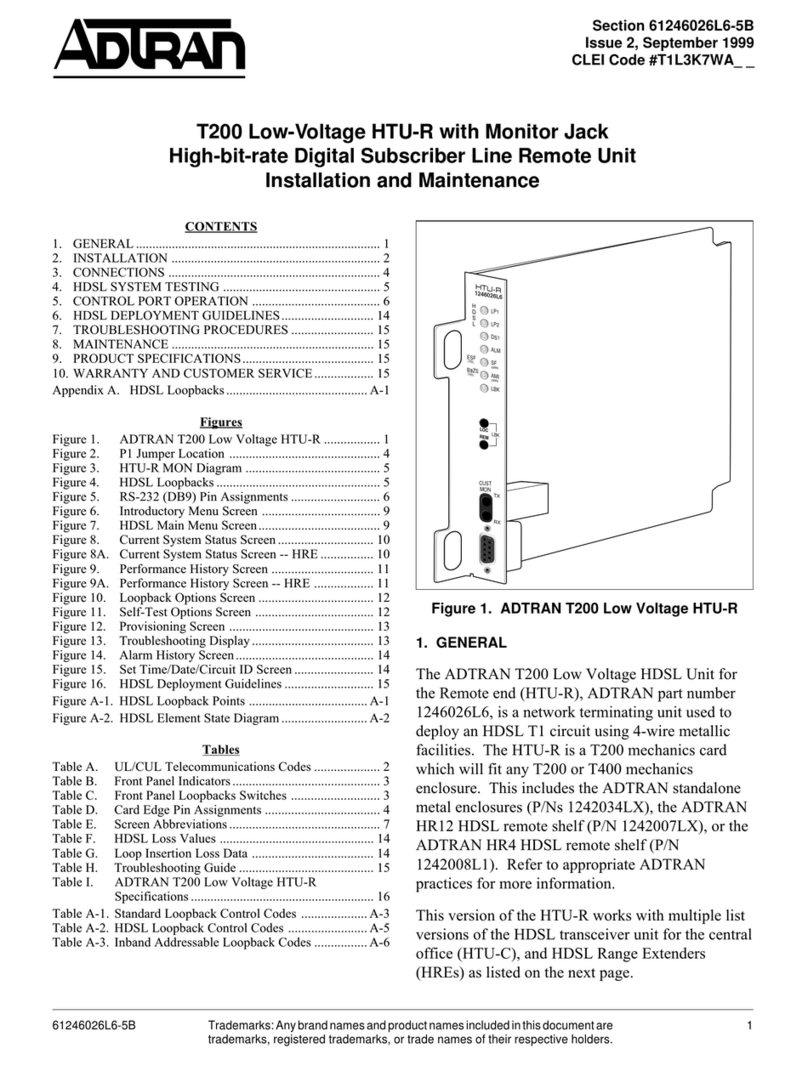
ADTRAN
ADTRAN T200 FNID Installation and Maintenance
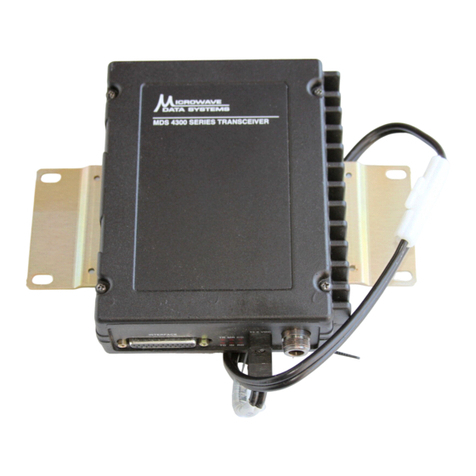
Microwave Data Systems
Microwave Data Systems MDS 4310 Installation, Operation & Field Maintenance
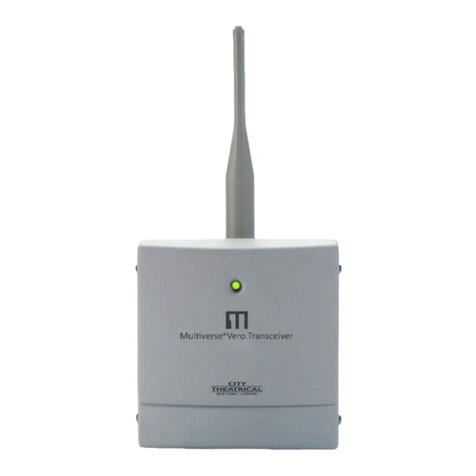
City Theatrical
City Theatrical Multiverse Vero 7400-5903 user manual
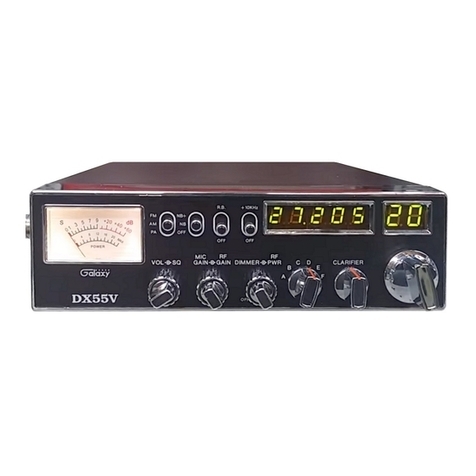
Galaxy
Galaxy DX-55V owner's manual
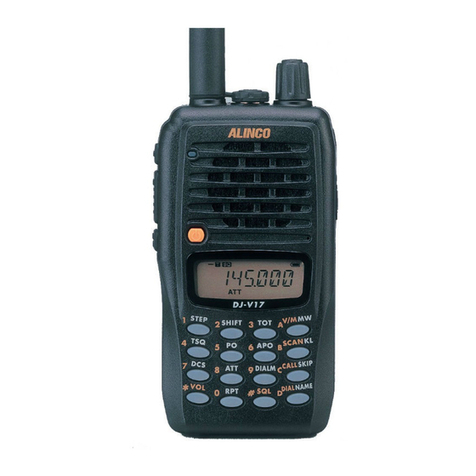
Alinco
Alinco DJ-V17TFH instruction manual
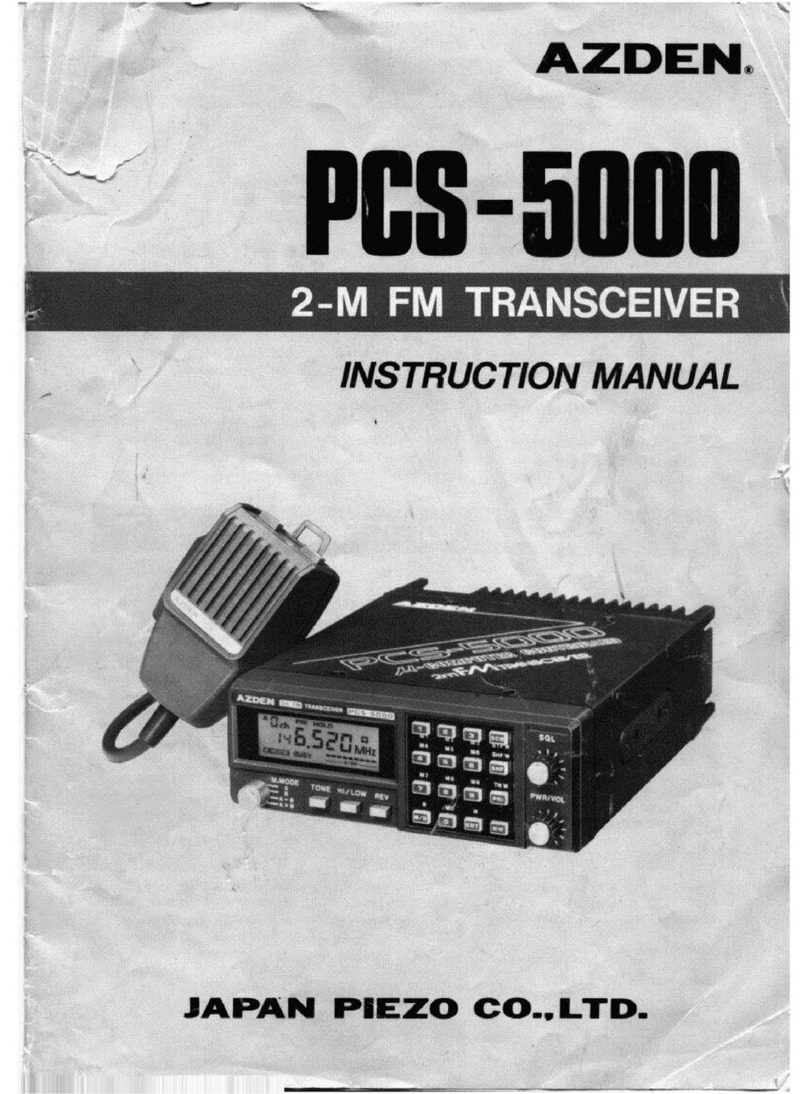
Azden
Azden pcs5000 instruction manual
